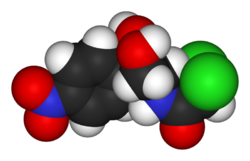Difference between revisions of "Chloramphenicol"
m (→Introduction) |
|||
| (9 intermediate revisions by 5 users not shown) | |||
| Line 1: | Line 1: | ||
| − | |||
| − | |||
| − | |||
| − | |||
| − | |||
| − | |||
| − | |||
| − | |||
| − | |||
| − | |||
[[Image: Chloramphenicol.png|thumb|right|250px|The 3D Structure of Chloramphenicol]] | [[Image: Chloramphenicol.png|thumb|right|250px|The 3D Structure of Chloramphenicol]] | ||
| + | ==Introduction== | ||
| + | Chloramphenicol orginates from cultures of ''Streptomyces'' and was one of the first antibiotics to be synthetically mass-produced. It is a dichloracetic acid derivative. Its analogues florfenicol and thiamphenicol are discussed at the bottom of the page. | ||
==Mechanism of Action== | ==Mechanism of Action== | ||
| + | Chloramphenicol works by inhibiting the transpeptidation of the peptide chain, during protein synthesis on the ribosomes. This will limit the growth and replication of bacteria but will not kill the bacteria so is a '''bacteriostatic''' antibiotic. | ||
==Spectrum of Activity== | ==Spectrum of Activity== | ||
| − | + | *It is a broad spectrum antibiotic active against most gram-positives, many gram-negatives and all anaerobes. It is also active against rickettsia and chlamydophilia. | |
| − | + | *''Pseudomonas'' and mycobacteria species are resistant. | |
==Pharmacokinetic Considerations== | ==Pharmacokinetic Considerations== | ||
| + | They are very lipophilic neutral small molecules, which are orally active and have a very wide volume of distribution. It is thus capable of penetrating cell membranes and will enter the CSF. It is eliminated in the liver via hepatic metabolism with only 10% being excreted in the urine unchanged. The half-life varies between each species and also with age of the animal. | ||
| − | + | ==Side Effects and Contraindications== | |
| − | + | * A reversible suppression of haematopoiesis occurs in cats when recieving high doses. It's use in cats should be limited to seven days. | |
| − | + | * Myocardial depression has been noticed following intravenous administration. | |
| + | * If it is given per os, dogs and cats often have gastrointestinal irritation. | ||
| + | * In man a fatal aplastic anaemia can occur, this has had severe implications on the veterinary world. In the EU it is now '''banned in all food producing animals in all of its forms''' (ie has no safe withdrawal period) to ensure it doesn't enter the food chain. The only licensed veterinary products are currently topical eye medication and off-shelf use of human oral and parenteral products in non-food producing animals. | ||
| − | + | ==Florfenicol and Thiamphenicol== | |
| − | + | These are both analogues of chloramphenicol with similar antibacterial activity. With these a higher percentage of drug is excreted unchanged in the urine. | |
| − | |||
| − | |||
| − | + | More importantly they aren't associated with aplastic anaemia in man and so are authorised to be used in food-producing animals. | |
| − | + | [[Category:WikiDrugs]] | |
Latest revision as of 11:54, 22 November 2013
Introduction
Chloramphenicol orginates from cultures of Streptomyces and was one of the first antibiotics to be synthetically mass-produced. It is a dichloracetic acid derivative. Its analogues florfenicol and thiamphenicol are discussed at the bottom of the page.
Mechanism of Action
Chloramphenicol works by inhibiting the transpeptidation of the peptide chain, during protein synthesis on the ribosomes. This will limit the growth and replication of bacteria but will not kill the bacteria so is a bacteriostatic antibiotic.
Spectrum of Activity
- It is a broad spectrum antibiotic active against most gram-positives, many gram-negatives and all anaerobes. It is also active against rickettsia and chlamydophilia.
- Pseudomonas and mycobacteria species are resistant.
Pharmacokinetic Considerations
They are very lipophilic neutral small molecules, which are orally active and have a very wide volume of distribution. It is thus capable of penetrating cell membranes and will enter the CSF. It is eliminated in the liver via hepatic metabolism with only 10% being excreted in the urine unchanged. The half-life varies between each species and also with age of the animal.
Side Effects and Contraindications
- A reversible suppression of haematopoiesis occurs in cats when recieving high doses. It's use in cats should be limited to seven days.
- Myocardial depression has been noticed following intravenous administration.
- If it is given per os, dogs and cats often have gastrointestinal irritation.
- In man a fatal aplastic anaemia can occur, this has had severe implications on the veterinary world. In the EU it is now banned in all food producing animals in all of its forms (ie has no safe withdrawal period) to ensure it doesn't enter the food chain. The only licensed veterinary products are currently topical eye medication and off-shelf use of human oral and parenteral products in non-food producing animals.
Florfenicol and Thiamphenicol
These are both analogues of chloramphenicol with similar antibacterial activity. With these a higher percentage of drug is excreted unchanged in the urine.
More importantly they aren't associated with aplastic anaemia in man and so are authorised to be used in food-producing animals.
